
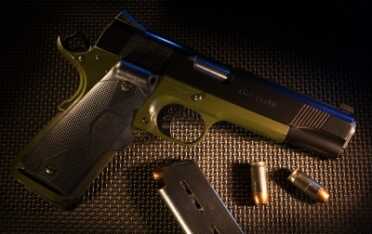
Three years of carry and thousands of rounds hardly show on this Wilson Combat CQB Elite’s green Armor-Tuff finish. Best of all, the gun has suffered only one stoppage, despite testing a variety of .45 ACP loads.
By Guy J. Sagi
Wilson Combat
www.wilsoncombat.com
I’ve been carrying the Wilson Combat CQB Elite for more than three years and its only hiccup came a few weeks ago, oddly in the hands of my eldest grandson about to deploy. For some rarely used self-defense handguns that would be a serious indictment, but this 1911 has sent thousands of rounds downrange, it’s been carried nearly every day and I’m not known for being particularly “gentle” to anything I own. Add the fact that field stripping and cleaning duties have been surrendered to my teen grandsons—eager for takedown practice, but not always thorough in cleaning and proper lubrication—and this handgun is lifesaving reliable.
Then there’s its eagerness to digest anything and everything I feed it. I think I’ve loaded and tested this gun with nearly every modern .45 ACP load on the planet. If I wipe it down after a full day of carry I feel guilty because I have too much time on my hands, and despite the bangs and bumps of a one-hour commute to work, each way, it still commands reverence at the range. It is, after all, a Wilson.
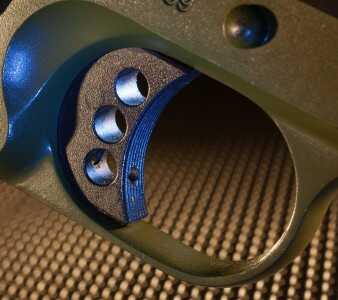
Light trigger let-off weights may be there when you open a new gun’s box, but this Wilson Combat has somehow maintained a crisp, 3-pound let-off weight, despite little more than routine maintenance in three years of carry.
Every 1911 Wilson Combat produces comes with a 1-inch-at-25-yards group guarantee. I’ve seen my gun deliver that kind of performance, albeit in the hands of a more experienced shooter (offhand, after complaining my grip panels were loose, no less). I haven’t been able to duplicate the feat, but the inherent accuracy is there. Part of the reason is the hand-fitted 5-inch match barrel and bushing, along with the handgun’s 6.6-inch sight radius.
OK, the grips weren’t snug when a good friend embarrassed me, but it’s hard to tell with all the other purchase-enhancing features the company built into the pistol. The frontstrap has 30 lpi checkering that covers just about every piece of real estate available there. Coupled with a similar treatment on the backstrap, it’s hard for this gun to “come loose” in your hands, even when shooting with gloves.
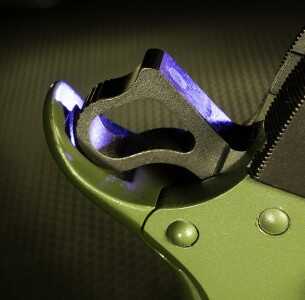
Wison Combat’s High Ride Bullet Proof Beavertail Grip Safety eliminates the chances of hammer bite. The skeletonized hammer also adds a nice touch to the handgun.
Then there’s the company’s Tactical Bullet Proof Thumb Safety. It’s serrated to ensure your thumb doesn’t come off as you ride it for follow-up shots, and just wide enough to make finding it almost intuitive. In the time I’ve carried this gun with a Milt Sparks IWB and Bianchi Foldaway, it’s never inadvertently become disengaged. Yes, I carry cocked-and-locked, get over it. Sorry southpaws, the safety is not ambidextrous.
A variety of sight options are available, but the post I have up front with a tritium insert feels ideal for self-defense. In bright light the black outline ensures precise shots with a classic sight picture, but that white dot (encircling the tritium vial) can get on target fast. In low light and darkness—the preferred office hours of criminals—the tritium insert glows a heartwarming and easy-to-acquire green. The front sight is dovetailed into the slide and is windage adjustable.
At the rear, a pair of tritium vials also rule the night and the white dots along with a U-notch ensure fast target acquisition in the daytime. Serrations help reduce glare in the daytime and as is always the case with Wilson Combat, the different options you can order are almost limitless.
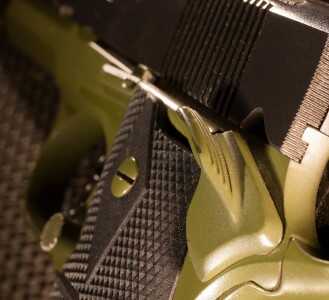
The Tactical Bullet Proof Thumb Safety has never inadvertently become disengaged in three years of carry and serrations ensure your thumb stays solidly put for fast follow-up shots.
To improve purchase for charging the gun and press checks, serrations are found at the front and rear of the slide (on the sides). And glare reduction touches are added atop the slide and 40 lpi serrations are found at its back.
Wilson Combat has long been known for its battle-tough magazines with an eight-round capacity, and when the gun arrived with only one I had no choice but to procure another three. The company’s Speed Chute Magazine Well makes reloads a breeze and, yes, there’s that lanyard loop mandated by the Cavalry during the 1911’s early years. But it’s flush (almost undetectable) at the bottom, so it’s no longer a palm-bruising-absurdity during tactical reloads.
With a skeletonized hammer and trigger, finished in black to nicely contrast with the green Armor-Tuff frame and slide, the CQB Elite is a real looker. The trigger is adjustable for takeup, although the way it arrived from the factory seems ideal. Despite my lack of real maintenance on this gun, even after three years of abuse, let-off weight is 3 pounds, even, according to my Timney Triggers Tension Scale. Best of all, there’s no creep, no grit, no grime and it is extremely consistent—ideal for delivering precise shots.

It’s not a perfect sight picture, but the night sights will certainly get the job done at bedroom distances in this case. Serrations at the back of the rear sight and slide do a good job of reducing glare.
Unfortunately, during accuracy testing I did anything but rise to this gun’s potential. Regardless of my efforts, the best five-shot group I could muster was 1 3/8-inch group from a sandbagged rest at 25 yards with Federal Premium’s 165-grain Guard Dog loads. Even that group had a called flyer—my day at the range after clipping one of my RCBS AmmoMaster chronograph screens was less than ideal, needless to say. Five, five-shot groups for the load averaged 2¼ inches and muzzle velocity averaged 1,018 fps.
The second-best load was Remington’s 230-grain BJHP Ultimate Home Defense load, with a 2¾-inch group average at 907 fps. Bringing up the rear was PMC Bronze 185-grain JHPs with an average of 3 1/8 inch groups at 898 fps.
There were no malfunctions, stoppages or failures to feed. The CQB Elite digests anything it’s fed, and at least that remained true at the range. Of course, part of that is attributable to the magazines.
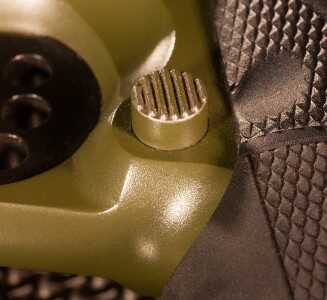
The company’s Bullet Proof Magazine Release has been every bit as reliable as the thumb safety in carry, having never inadvertenly dropped a magazine on presentation or holstering.
Some may question why I need four magazines for my carry gun. Most who write about self-defense make a pretty strong case that you should always have a reload on hand. I won’t argue the point, although I will admit I’m not as good about having a spare mag as I should be. In my case, four magazines make things easier during my periodic trips to Gunsite Academy and other tactical schools. If you’re paying for range time and bringing only one magazine, how much time are you losing to reloading? Bring at least two and if you have a shooting partner, they stuff while you practice (and vice-versa).
More importantly, though, they’re probably any gun’s weakest link. Springs and followers don’t like dirt. Yes, we drop them during speed reloads, but then they fill with sand or the lips get bent, so cartridges don’t feed and we start cursing the gun when it’s just a magazine problem. So I keep four. If one messes up in the next few months it’ll either get inspected and fixed, or tossed. But when I get home from the range, how do I tell which one of my identical quartet is the culprit? I hope you’re marking or numbering your magazines before they go near your range bag, too.
The Wilson Combat CQB Elite weighs 36.6 ounces unloaded. Overall length is 8.7 inches and its height is 5.6 inches. With a width of 1.3 inches, it’s not out of the question for everyday carry—I’ve been doing it for a long time. You do, however, need to be careful in regard to covering clothing. There may be better choices out there, but there’s something about a 1911 chambered in .45 ACP I trust. The worst thing I can say is after the seven-hour drive to North Carolina the grip starts to get a little annoying in my side. It’s also available in 9 mm, .38 Super, .40 S&W and 10 mm chamberings.

Unlike many other 1911s out there, the embellishments on the CQB Elite are understated in a manner befitting this gun’s purpose. Gaudy and loud lettering on a gun that may be used in low light could reflect, giving away your position in a self-defense situation.
My Wilson Combat CQB Elite has been nearly as reliable as the sun rising, but this love affair had a rocky beginning, cosmetically anyway. The G10 grips provide plenty of purchase, and they come with a cool, gold-colored Wilson Combat logo centered on the panels. I’m not much into this kind of embellishment, but they did give the gun a classy look lacking from my other carry options.
Unfortunately, after about 500 rounds one of the Wilson Combat logos fell off. I admit it makes a unique challenge coin, but stuff coming loose and rolling around on the ground like a hubcap lost from a speeding Mercedes in a gunfight is not my idea of a good time. Another writer I know had his grip panels suffer a similar fate and his remedy was Super Glue. I’m not sure how that will turn out, but if I’m carrying one of John Moses Browning’s most reliable designs in a fight-stopping chambering, I shouldn’t need to inventory grip-panel bling after every range session.
I ditched the grips and tried a different pair I thought would match the green finish on the slide and frame. All greens are not created equal—who knew? The homely, unmatched colors became something of a joke at my old job. Worse yet, when riding the gun high, I had only a 50-50 chance of disengaging the High Ride Bullet Proof Beavertail Grip Safety (despite the speed bump). Talk about something that gets annoying fast at the range, possibly deadly in a self-defense situation. I even invested in a bicycle-tire inner tube to semi-permanently hold it down, although if I had enough cash Novak’s The Answer would have been the ultimate solution to that cavalry-mandated feature.
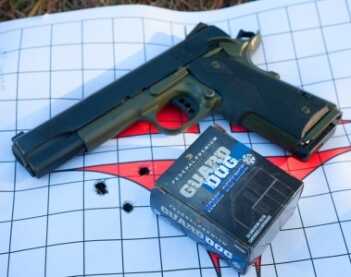
It was a tough day on the range, one that claimed a chrony screen and scattered groups—undeniably shooter error. Despite the frustration, the author did get a five, five-shot group average of 2 1/4 inches with Federal Premium Guard Dog loads at 25 yards. But, he’s seen the CQB Elite do much better.
Today my CQB Elite wears Crimson Trace Lasergrips. Not only does it help me connect better at the range (although they were not used in accuracy testing, obviously), it also gives me the confidence I’ll need if a home invasion occurs. And, except for when I’m shooting off sandbags, that backstrap safety disengages 100 percent of the time.
Base price for a Wilson Combat CQB Elite starts at $3,425. That may seem a little steep, until you consider mine has suffered only one stoppage, despite the years, variety of loads and relative abuse. I’d tell you it’s a wise choice because it will be the last 1911 you’ll ever buy, but we all know you can never own too many 1911s. The simple truth is this is a gun upon which you can bet your life, and that makes it a pretty sound investment.

Funny you should mention loose grips, this has been the only issue with my Wilson too!
Pricey, but I sure would want one. Professional model, stainless and black armor-tuff coated slide, with…
I bought and assembled a 1911 45 caliber based on a Wilson frame and slide assembly back in 2009 after I came back from Afghanistan. That is as close to a Rolex as I will ever get. The fit and finish with that assembly was SOOOOOOO smooth and tight that I was reluctant to even build the pistol. Yep, it was that good. I was trained as a DoD Machinist so, I know. Needless to say, it is the best pistol that I own. I would like to buy another one but, why? Believe me, if you can get your hands on one you WILL NOT be disappointed.
hello my name is Dennis i love the 1911 and the green on black with the crhome slide. i have one pistol purchace permit only need one. this one will be my first hand gun. that i will keep forever i have been looking and shot alot of pistols and i need one for myself. i have some money. how much and can you please help me out ?
its a buity
I have a friend that shoots a Wilson. It is a great weapon and I enjoy shooting with him against my Kimber CDP with Hogue Soft Rubber grips with finger grooves. We trade victories. I find like other great tools, it comes down to a matter of personal taste. We both throw tight groups at various ranges with a wide range of ammo. I just like the way my Kimber feels better.
It sounds to me as if you had a “Fat” Cartridge. Unless the cartridge was damaged in your attempt to remove it, I would have later compared it to a good round. I have in years of firing thousands of factory 45 ACP ammunition, found a “fat” round and also other factory rounds where the bullet was either seated too far down in the case and in some cases, (pun intended), not seated down in the case far enough. Both instances causing dangerous conditions. On the accuracy of your Wilson CQB handgun? I have a very old Star 45 (tight as a drum) that will shoot in the neighborhood of one and a half inch groups from the bench.
Yeah, this gun usually does a ton better. But I had to report how the test turned out that day, when it was more formal….and it was an ugly day at the range. OK, the day was fine, my performance behind the trigger was hideous.
I wish they would make Guard Dog in Sig 357. please
Yes, 357 Sig would be wonderful. Hopefully the Federal folks are watching.
Just curious…. you talk about an “issue” twice in the article, once in the hands of your grandson, but fail to explain what it was? How about an answer if you know?
Truthfully I have no evidence to support my suspicion, however, here are the details. My grandson was running a second magazine through the Wilson and I was working with him on shooting the reset (they don’t teach Soldiers that in basic, apparently). Well, he’s got the trigger fully back, lightens pressure until he feels that “click,” and when he hit the trigger again, nothing. No big deal, he ran the tap, rack, bang drill like a, well Soldier. Unfortunately, a live round was in there, apparently not fully seated because the gun was slightly out of battery. We dropped the mag and tried to manually rack the slide, but either I’d run the gun totally dry or that factory cartridge was a little fatty (it really wasn’t funny at the time because the gun was very close to being in battery). About 15 minutes later I managed to get the slide back, the cartridge ejected, we oiled and it has run perfectly since. Obviously I discarded the cartridge, but it didn’t look like there were any undue scratch marks on its sides and the chamber looked pristine after we cleaned. I’m sure open to second, third and fourth opinions. I’ve got the gun right here and certainly not above field stripping and taking second looks.
I have a 1991A1 Colt 45 1911 I’ve carried it for 6 years shot everything under the sun and no mal functions of any kind. The only thing I changed on the gun was the mainspring housing to steel. I also changed the triger to a steel original Colt. The best thing it only cost me $600.00. It easly shoots 1.50″ groups at 25 yards.